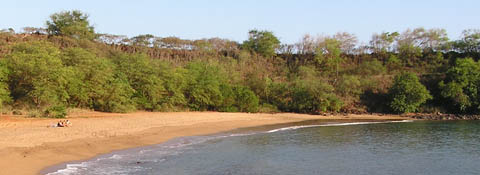www.islandbreath.org ID# 0401-01
SUBJECT: BEACH ACCESS
SOURCE: NOLA CONN nolaconn@hotmail.com
POSTED: 1 Feb 2004 - 9:00am
Is Beach Access a Civil Rights Issue?

A beach accessed only by permit on south shore
by Walter Lewis on 1 February 2004 At the same
time, the desire to protect private property is understandable.
We can work out our differences and achieve our common goals,
with grace and respect for one another instead of lawsuits and
dissension. |
SOURCE: THE GARDEN ISLAND NEWS http://www.kauaiworld.com
POSTED: 5 January 2004 - 8:00am

The beaches
of Kaua'i are at the heart of the bountiful benefits provided by
our island to our citizens and visitors and may well be Kauai's
most valuable asset. Hawaiian law directs that all beaches shall
be publicly owned, and it is essential that there be reasonable
public access to them. In most cases the access required is across
lands having private ownership.
The consequences of the ambivalence and neglect by the County are well illustrated by the recent Papa'a Bay incidents. In that situation, according to news reports, the Mayor referred to the County Attorney a request for a "title search" relating to the Papa'a Bay easement. This was essentially a futility because that access was regarded as undocumented and such a search would not disclose unrecorded usage. It seems simply a maneuver to escape accountability. A meaningful request would direct the County Attorney to assist in a program to assure the validation of the now undocumented accesses. A group of residents believing in good faith that they were entitled to use a trail that had historically given access to the beach were met at the site by an owner who claimed to be protecting his property rights and denied passage. The resultant confrontation was escalated by a County directive to the police to support the landowner and arrest persons trespassing on his property. Under this authority several arrests were made, although it is not clear whether any actual trespass occurred. The police should have been instructed that members of the public were entitled to peacefully assemble on public property and no trespass, civil or criminal, could exist until there was an actual entry on private property. The controversy is, according to news reports, now compounded by the filing of a lawsuit by the owner claiming slander of title and tortuous injury. |
SUBJECT: BEACH ACCESS
SOURCE: RAY CHUAN rchuan@aloha.net
POSTED: 1 January 2004 - 2:20am
A Brief History

Kauai Beach Access – Thirty Years of Neglect…..and Continuing
Public interest
in beach access was heightened in 2001 during the great debate at the
County Council over whether Kauai County should accept a gift of a section
of the coast at Kealia by the developer of Kealia Kai with many conditions,
some quite onerous, especially the one allowing the developer to maintain
his own private security guards on the public beach. At the end
of a string of tumultuous debate, at the beginning of which then Councilman
Bryan Baptiste swore he wouldn’t change his mind – about
accepting the gift with the conditions – “no matter what
anybody says!”, the Council voted, unanimously, to reject the
gift with the conditions. The developer immediately retreated,
deleted the onerous conditions; and the County accepted the gift of
coastal land and access ways.
After further coaxing, accompanied by much chuckling at Council sessions, the Planning Commission in late 2002 finally cleaned up the ordinance – twenty-eight years after the mandated implementation of HRS 46-6.5. How many opportunities for acquiring beach and mountain access were lost nobody knows. One may, however, glean some idea of lost opportunities by referring to the last time the county bothered to take a look at the status of public ac cuss in a report prepared by a consultant in 1990 and published in 1993. This report listed 214 beach accesses in four categories
|
Pau